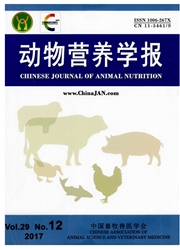

 中文摘要:
中文摘要:
本试验旨在探讨抗性淀粉(RS)对饮食诱导肥胖(DIO)大鼠排便状况及肠道菌群的影响,为合理利用RS提供依据。选用100只健康雄性SD大鼠,随机分为2组,对照组10只饲喂基础饲粮,高脂组(HF组)90只饲喂高脂饲粮,7周后根据体重从HF组筛选出DIO大鼠27只,随机分为3组,每组9只,分别为HF组(饲喂高脂饲粮)、高脂饲粮抗性淀粉组(HFRS组,饲喂含10%RS的高脂饲粮)、高脂饲粮抗性淀粉+硫酸葡聚糖(DS)组(HFRS+DS组,饲喂含10%RS的高脂饲粮),试验期间HFRS+DS组每天用5%DS 1 mL灌胃,其他组分别用蒸馏水1 mL灌胃,试验期5周。于第7、12周收集新鲜成形大便1 g,稀释后用选择性培养基进行肠球菌、肠杆菌、双歧杆菌、乳酸杆菌、类杆菌检测并计数菌落总数。结果表明:1)试验第7周时,与对照组相比,HF组大鼠粪便湿重、粪便含水率以及粪样中肠球菌、双歧杆菌、乳酸菌、类杆菌数量显著降低(P〈0.05),粪便颗粒数、粪样中肠杆菌数量显著升高(P〈0.05)。2)试验第12周时,与对照组相比,HF组DIO大鼠粪便湿重、粪便含水率以及粪样中肠球菌、双歧杆菌、乳酸菌、类杆菌数量显著降低(P〈0.05),粪便颗粒数、粪样中肠杆菌数量显著升高(P〈0.05);与HF组相比,HFRS组DIO大鼠粪便湿重、粪便干重、粪便含水率以及粪样中肠球菌、双歧杆菌、乳酸菌、类杆菌数量均显著升高(P〈0.05),粪便颗粒数、粪样中肠杆菌数量显著降低(P〈0.05);与HFRS组相比,HFRS+DS组DIO大鼠粪便湿重、粪便含水率以及粪样中双歧杆菌、乳酸菌、类杆菌数量显著降低(P〈0.05),粪样中肠杆菌、肠球菌数量显著增加(P〈0.05)。由此可见,本试验条件下,RS可改善DIO大鼠排便状况和高脂饲粮造成的肠道菌群紊乱。
 英文摘要:
英文摘要:
This experiment was conducted to discuss the influence of resistant starch(RS) on defecation and intestinal microflora of diet induced obesity(DIO) rat,to provide basis for the usage of RS.A total of 100 health male SD rats were randomly divided into two groups,basal diet was given to the control group which with ten rats and the high-fat diet was given to the high-fat group(HF group) which with ninety rats for seven weeks.Then twenty-seven DIO rats were picked out on the ground of their weight from the HF group,and randomly divided into three groups with nine replicates per group.Each group was offered one of the following diets:the high-fat diet in HF group,the high-fat diet with 10% RS in high-fat and resistant starch group(HFRS group) and high-fat and resistant starch + dextran sulfate group(HFRS + DS group).The experimental period was five weeks.During period,1 mL 5% DS was given by gavage to HFRS +DS group,while 1 mL distilled water was administrated to other two groups.One gram fresh feces was collected in the 7thand the 12 thweek.The number of Bacillus coli,Enterococcus,Bacillus bifidus,Lacticacid bacillus,and Bacteroid were tested using selective culture medium after dilution.The results showed as follows:1) in the 7thweek,compared with the control group,wet weight and water content of feces,and the number of Enterococcus,Bacillus bifidus,Lacticacid bacillus and Bacteroid of feces in HF group were significantly decreased(P〈0.05),while the pellet number and the Bacillus coli number of feces in HF group were significantly increased(P〈0.05).2) In the12 thweek,compared with the control group,wet weight and water content of feces,and the number of Enterococcus,Bacillus bifidus,Lacticacid bacillus and Bacteroid of feces in HF group were significantly decreased(P0.05),while the pellet number and the Bacillus coli number of feces in HF group were significantly increased(P〈0.05).Compared with the HF group,wet weight,dry weight and water content of feces,and
 同期刊论文项目
同期刊论文项目
 同项目期刊论文
同项目期刊论文
 期刊信息
期刊信息
